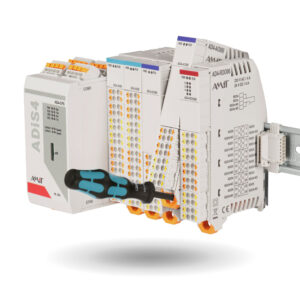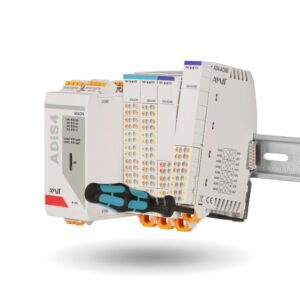Who doesn’t know the ADiS modular control system? Even if you’ve never installed this system, you probably know about it. Why? Because it is currently the oldest control system produced by AMiT in its original design. We started the first deliveries of this system back in 1995. Yes, almost 30 years ago! So it was high time for a major generational change. Therefore, let us introduce the new modular system with the designation ADiS4. What is good to know about the new system?

Housing
For the development of ADiS4, we teamed up with the most competent in the field of mechanical solutions – Phoenix Contact. We have adopted their proven concept of modular I/O modules with an original modular backplane built directly into the 35 mm DIN rail. The backplane “grows” with each module. Nothing is extra, nothing is missing.
Each module of the control system can be added, removed or replaced very easily and quickly. First, all signal terminals are released in one movement, followed by another, even faster movement of the module itself. Each module indicates its own status by LED (power supply, communication) and, for digital signals, also their status.

Terminals
This is the first time we have used Push-in connector clamps for this control system. This allows the wires to be plugged into the terminals virtually with one hand without the use of any tools. Several independent tests have shown that this can reduce assembly times by up to half compared to screw clamps and even spring clamps. Signal wiring, installation and replacement of control system modules must be experienced first-hand – you won’t want to use other solutions.

Bus
Not only the mechanical design of ADiS4 is interesting, but also the communication with the modules. The core of the system itself is the new two-bus system communication between the modules and the central unit. Up to 64 modules can be connected to a single assembly, with up to 16 signals per module. So handling 1024 signals in one assembly is no problem. But that’s not all. The speed of servicing all signals in such an assembly is as low as 2 ms (two milliseconds).
Input/output modules
Currently, the basic input/output modules are offered – digital inputs including counter inputs, digital outputs, analogue inputs in AMiT in common ranges (voltage, current, RTD, NTC) and analogue outputs (voltage, current). Of course, the relay output must not be missing. A list of current modules can be found on the ADiS4 system product page. We are currently working hard on other module types.
Communication
Currently, physical communication capabilities are determined by the capabilities of the central units. In the basic offer you will find two units. The first one has only Ethernet connection in the form of a switch (2 connection points), the second variant has in addition RS485 and RS232 interfaces. In general, the concept of the central unit is prepared for the use of 2 serial interfaces – in addition to the mentioned RS485 with galvanic isolation and RS232, variants with CAN interface can also be offered.
In the near future we will offer e.g. a communication module with two RS485 interfaces. Up to 20 of these modules can be connected to the assembly at the same time with a maximum communication rate of up to 115.2 kbps each. This will significantly expand the communication capabilities of the ADiS4 system, similar to its older predecessor.

Next generation system
ADiS4 belongs to a next generation of AMiT systems called Gen2 E+. This means that you can take advantage of the state-of-the-art programming offered by the DetStudio environment for these systems. It also supports modern communication with master systems and between the control systems themselves (support for websockets, MQTT, etc.). This generation of control systems is also ready for use in information systems that meet the demanding requirements of cyber security. Support for integrated web visualisation directly in the control unit is a standard feature
Detailed information and documentation on the ADiS4 modular system can be found on our website now. Since it is a modular system, its further development will probably be similar to its predecessor – we will gradually add more and more input/output and communication modules, which will be more or less specialized and address specific issues. We believe that we have succeeded in preparing a concept that will ensure the ADiS4 system a similar long successful sales life as the original ADiS system from the nineties…

